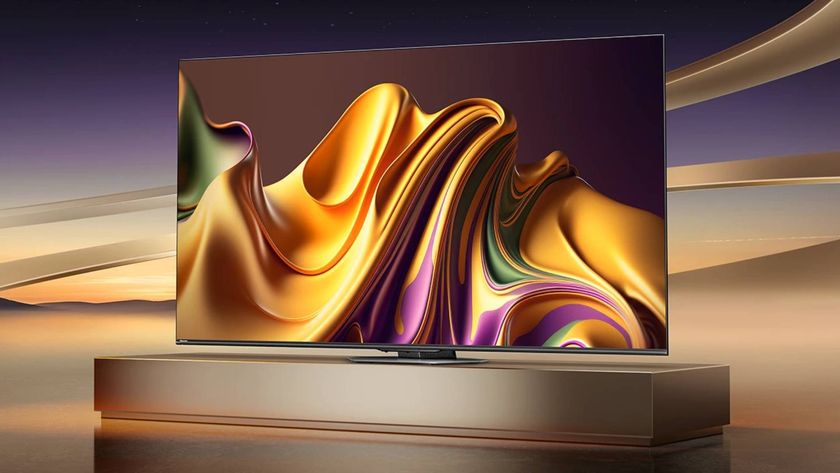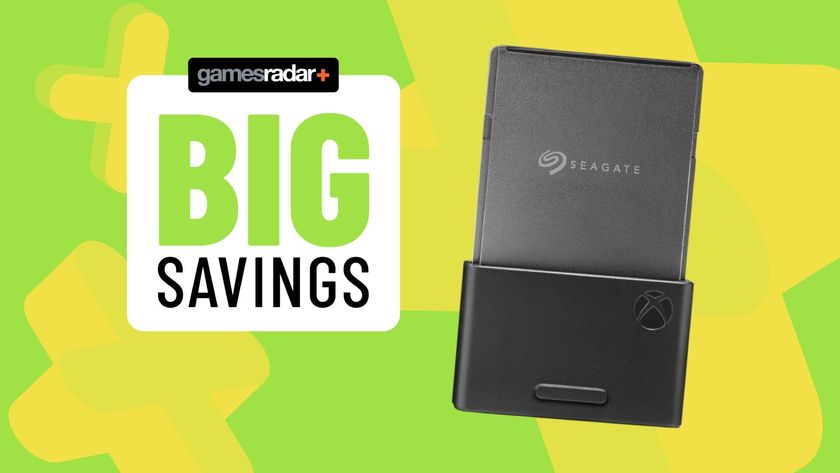Best gaming TV in the UK 2025
Packed with excellent gaming features, these are our top picks of the best gaming TVs for PS5, PS4, Xbox Series X|S, Switch, and PC
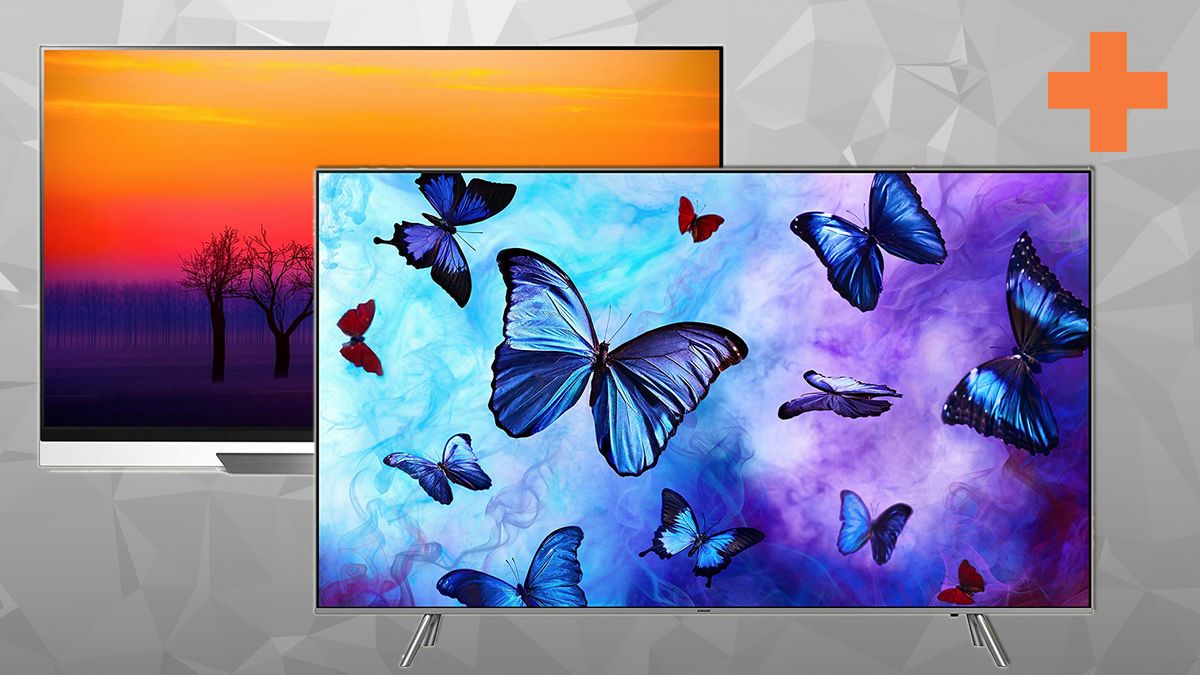
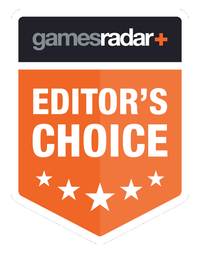
Investing in the best gaming TV is essential if you're rocking a PS5, Xbox Series X, or Nintendo Switch, as the latest displays will help you make the most of your chosen platform’s features. Whether your setup is armed with a brand new console or you’re looking for something larger for your PC, there’s an abundance of different screens out there that’ll serve as an immersive portal. If you're still using that old 'HD Ready TV' you picked up years ago for your Xbox 360 or PS3, now could be the perfect time to revamp your setup with something more contemporary.
It's easy to feel overwhelmed when hunting for the best gaming TV, especially with the number of models available. For the most part, you'll find that OLED screens rank pretty high thanks to their superior contrast and colour capabilities, but there are plenty of alternatively that offer up better specs while still using a traditional LED panel. If you're looking to strike somewhat of a balance mini LED TVs are also worth a look thanks to their elevated brightness, not to mention that QD-OLED tech is starting to take the scene by storm.
Whether you're after a premium 4K powerhouse or a screen with other high spec qualities, you'll be sure to find the perfect panel for your need down below. We've also made sure to cover all bases when it comes to budgets, as not everyone is looking for a cinema size screen with a monstrous price tag. Striking a balance between cost and functionality is key when it comes to buying new screens, and we've tested enough of them to lend you a helping hand.
The best gaming TV overall





Specifications
Reasons to buy
Reasons to avoid
The G3 OLED TV is the first flagship flatscreen from LG to feature a Micro Lens Array (MLA) panel with advanced brightness boosting algorithms, making it 70 percent brighter than entry-level OLED models.
Ingenious Light Control Architecture and α9 AI Processor Gen6 create headroom for brighter peak whites without increasing power usage, meaning pictures have incredible dynamic snap and colour vibrancy.
Significantly, all four HDMI ports are 4k 120HZ capable, with eARC on HDMI 2. This provision makes the G3 an excellent option for console gamers. There’s also Freesync Premium and NVidia G-Sync VRR support for anyone interested in hooking up a gaming PC. A dedicated Game Optimizer menu groups all key gaming settings together, making for an easy time when fine-tuning the TV's various settings.
The panel supports HDR10, HLG, and Dolby Vision, but there’s no HDR10+ support. Its webOS platform has an all-new two-page design with nested folders for easier navigation. The G3 also features advanced AI for both imagery and audio, virtual 9.1.2 upscaling, and decoding of DTS, DTS X, and IMAX Enhanced audio.
Available in four screen sizes - 55-, 65- 77- and 83-inch screen sizes (OLED55G3, OLED65G3, OLED77G3, OLED83G3) - the G3 is designed to be wall mounted, so, unfortunately, no pedestal stand is included in the box. This is a pity, as you’ll have to budget for some optional boots.
Regardless, we rate the LG G3 OLED TV as a top-of-the-line model that is perfect for both gaming and boxset bingeing - provided you can afford the lofty price point.
The best gaming TV under £500
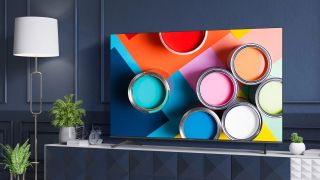
Specifications
Reasons to buy
Reasons to avoid
Available in five screen sizes, from small to massive, this new Hisense A6G TV impressed us as an excellent entry-level 4K HDR screen. And if you're looking to get one of the best gaming TVs for less than that $500/£500 mark, then this is the one to go for as all but one of the sizes are below that price tag. This is incredible value for money.
Design is de rigueur, with a slim bezel and spaced-out feet, and in terms of connections you're well equipped with three HDMIs on the rear. While there’s no 4K 120Hz support, we are paddling in budget waters here, but each of these ports does support ALLM (Auto Low Latency Mode) and VRR (Variable Refresh Rate), plus eARC. Also, Hisense claims an input lag of better than 20ms, but we measured it at a slower 48.2ms (1080/60) with Game mode selected during our testing.
But, especially for the price, the overall picture performance is good, with excellent fine detail and reasonable dynamics. Dolby Vision helps a lot, effortlessly making the set shine with Dolby Vision shows. We found the motion handling is accomplished too: 60Hz MEMC (Motion Estimation Motion Compensation) interpolation, presented in a variety of strengths, works well for general TV and sport.
The US iteration has Android TV with Chromecast built-in, while the UK version of the A6G comes with Hisense’s own Vidaa smart platform, plus Freeview Play - that translates to a good selection of streaming and catch-up players. So, all in, that's a win-win, and this Hisense is easily one of the top budget contenders for best gaming TV.
The best gaming TV for most players
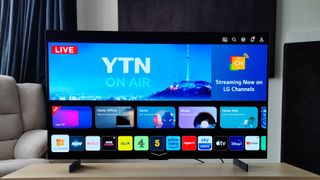
Specifications
Reasons to buy
Reasons to avoid
The LG OLED42C3 is the smallest of LG’s C3 models, and is aimed at movie fans looking for a bijou telly box and gaming enthusiasts looking for a large desktop TV display. Powered by the latest Alpha 9 Gen 6 processor, this screen maintains a high level of AI sound and vision management, but it lacks the brightness boosting algorithms found in larger models. Still, it delivers impressive picture quality with superb fine detail, punchy contrast built from inky blacks, and vibrant colours.
The 42-inch C3 offers various picture pre-sets, with Cinema and Cinema Home modes delivering a more theatrical performance and enhanced colour saturation. Motion handling is excellent, with effective options to reduce judder without sacrificing image quality.
The set’s HDR performance is solid, although it lacks support for HDR10+, the preferred HDR standard of Prime Video. On the sound front, the TV's downward firing speakers are functional but may benefit from a soundbar upgrade.
We think the TV excels as both an everyday screen and a near-field gaming display, thanks to universal 4K 120Hz HDMI support, VRR and ALLM coverage, and a dedicated game interface. Support for Freesync Premium and NVIDIA G-Sync VRR, make it suitable for high frame rate gaming. Latency is good. We measured input lag at 13.1ms (1080/60).
While not as bright as the larger (55-inch upwards) C3 models, the LG OLED42C3 TV still provides top-notch picture quality, extensive gaming features, and a sleek design. Unfortunately, the high price tag might limit its overall appeal.
The best QD-OLED TV
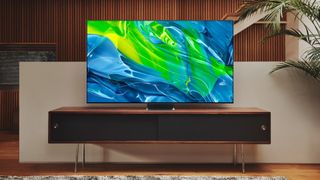
4. Samsung S95B
Specifications
Reasons to buy
Reasons to avoid
Gloriously slim, with class-leading luminosity, this first QD-OLED from Samsung is eye-catching in every sense.
The panel combines characteristic OLED black levels with the high peak brightness and the expanded colour volume of Quantum Dot technology, making it a brilliant choice if you prefer to use your TV in a room with high levels of ambient light.
All four HDMI inputs are v2.1 and support 4K 120fps sources, while there's also VRR (Variable Refresh Rate) with NVIDIA and AMD FreeSync support, plus ALLM (Auto Low Latency Mode). Samsung also has a dedicated Game Hub interface. Input lag is low in Game mode; we measured it at 9.6ms (1080/60). HDMI 3 also has eARC, for use with a Dolby Atmos soundbar. In addition to this HDMI quartet, there’s a trio of USBs, a digital optical audio output, and Ethernet, and wireless connectivity covers Bluetooth and Wi-Fi - so you're well catered for no matter your setup
The smart platform of choice here is Samsung’s Tizen. It has a wide variety of streaming services on tap (Netflix, Prime Video, Disney+, AppleTV+, BBC iPlayer, to name just a few), as well as Samsung’s own TV Plus IP-delivered channel service. It’s also compatible with SmartThings-connected devices.
Of course, the key attraction of the S95B is its QD-OLED panel and matching Neural Quantum Processor. The latter uses AI-driven Optimization to manage sound and vision, so you don’t need to think too much about it.
The image quality is spectacular. The level of detail is excellent, and its HDR performance is remarkable. We measured peak HDR brightness in excess of 1400 nits. Unfortunately, there’s no support for Dolby Vision, but you do get HLG, HDR10, and HDR10+ compatibility. It’s not just peak HDR brightness which glows: the set’s average picture level is high and this makes it easy to view in bright rooms, but can make for a fatiguing watch. It’s not subtle, and even the Game mode looks overwrought. On the plus side, 4K 120fps playback is buttery smooth.
All things considered, the Samsung S95B is a highly impressive QD-OLED debut. Its peak brightness is phenomenal, and colour depth is high. It never looks particularly cinematic though, and even in Game mode, pictures can seem over-saturated. Some will love the presentation though, and it's a great gaming TV and could set the scene for a new section of the best gaming TV market to come henceforth.
The best QLED TV
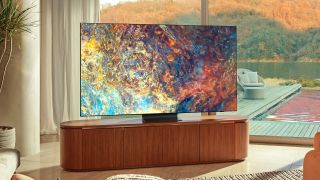
Specifications
Reasons to buy
Reasons to avoid
For those looking to get the best gaming TV that 2021 has to offer, we think the Samsung QN90A is an exquisite proposition. Evolving its already-brilliant QLED panel tech the QN90A, we found that this Mini-LED-powered 4K flagship has deep blacks, terrific quality, vibrant colours and contrasts, and exquisite HDR management.
Simply put, we found the image quality is superb, thanks to an advanced AI-powered Neo Quantum 4K processor, while an Intelligent Mode optimises all sources, making it an easy screen to live with, whatever you watch, and whatever you prefer.
The television comes with one of Samsung's One Connect Boxes which connects to the set via a fibre optic cable, while an extra unit to factor into the setup, this does allow for four HDMI 2.1 connections meaning anyone with a multi-gaming-device setup is surely catered for well. Smart connectivity is provided by Tizen, Samsung’s smart TV platform and there’s a wide range of apps available, including Netflix, Prime Video, Apple TV+, Disney+, and Now, plus all the usual catch-up TV services.
We are really excited about the new Game Bar feature, too. This is a dedicated interface for tweaks and adjustments that makes for excellent customisation and tinkering. Latency is very good: we measured input lag at 10.1ms (1080/60), in standard Game mode. When it comes to HDR, HDR10, HLG, and HDR10+ Adaptive are all supported, but there’s no Dolby Vision compatibility, which is a shame - but still doesn't impact the overall performance of the TV.
Even the TV sound system is nicely improved and very good, thanks to Samsung’s OTS+ sound system. Overall, a stunning high-end 4K TV for gaming option, and if you want the absolute best 4K QLED screen Samsung makes, then the Neo QLED QN90A is it. For us, the best Samsung gaming TV.
Read more: Samsung QN95A review
The best mini LED TV






Specifications
Reasons to buy
Reasons to avoid
The XR-75X95K is Sony’s first ever TV to deploy Mini LED technology - a system where using much smaller LED backlights allows far more of them to be squeezed into the TV’s 75-inch screen, delivering potentially more brightness and, even more importantly, finer light controls.
Controls are backed up by an impressive 600 separately controllable dimming zones. The cutting-edge screen technology is backed up by support for 4K/120Hz gaming, VRR and Dolby Vision HDR - though the two gaming-specific features here only work across two HDMIs, not all four. Smart features are provided by Google TV. This isn’t our favourite smart system due to its rather overwhelming and sometimes dictatorial feeling home screen. But it’s content rich and easier to get on with than its Android TV predecessor.
You’d never guess this was Sony’s first Mini LED rodeo from its picture quality. Immediately we were struck by how bright and colourful its images looked with both gaming and video sources, with its brightness, in particular, pushing comfortably beyond anything OLED screens can currently achieve. This ensures HDR pictures in particular enjoy spectacular, lifelike intensity and richness - though over time we also noticed how all this raw spectacle isn’t coming at the expense of an appreciation for the finer things in life such as pretty much infinitely subtle colour blending and shading, excellent shadow detailing, and precious little sign of lost shading and details in the very brightest HDR picture areas.
Black levels and backlight controls are mostly excellent by LCD TV standards too (if you can avoid watching from a wide angle, anyway), while the potent visuals are joined by a powerful, detailed and dynamic audio performance that rounds out the TV’s cinematic credentials perfectly. Occasional softness when showing motion and minor ‘flatness’ with mid-dark imagery don’t even come close to stopping the 75X95K from being overall an outstanding TV for its money.
The best small-scale gaming TV






Specifications
Reasons to buy
Reasons to avoid
This Sony A90K OLED gaming TV might be relatively bijou, but it’s packed with advanced picture-making tech. Also available in a 48-inch version, this set shines as both a near-field gaming monitor, an everyday TV, and one of the very best gaming TVs you can buy.
The star of the show, and key to its outstanding image clarity, is Sony's Cognitive Processor XR, which cleverly prioritises the elements of an image that our eyes naturally focus on. The result is a presentation that’s always detailed and dynamic. The A90K looks great with 4k streaming services, and the 4K 120fps gameplay is velvety smooth.
A downsized version of Sony’s Acoustic Surface Audio+ delivers crisp audio, courtesy of actuators that vibrate the screen. This technology works fine for dialogue clarity, but falls short when it comes to bass depth; the A90K can sound a little thin. There are four HDMI inputs, two of which are v2.1 enabled and capable of 4k 120fps playback. These also support VRR (Variable Refresh Rate) and ALLM (Auto Low Latency Mode). One of the v2.1 inputs supports eARC but that happens to be one of the HDMI 21. ports... The set also has two USB inputs, a digital optical audio output, and Ethernet for Bluetooth and Wi-Fi connectivity.
The A90K runs on the Google TV smart interface, which boasts all the popular streaming services such as Netflix, AppleTV+, Disney+, and Prime Video. There’s also support for Chromecast, Apple AirPlay, and Homekit.
Overall HDR performance is good, with high peak brightness measured at 700 nits with a 5 percent patch. HDR support covers Dolby Vision, HDR10, and HLG, but there’s no compatibility with HGiG, the HDR gaming standard. Connect a PlayStation 5 and you’ll benefit from Auto HDR Tone Mapping and Auto Genre Picture mode selection, which is useful. Input lag is average though, just 15ms (1080/60).
Overall, the Sony A90K is a superb-looking small-screen OLED, but be aware of the niggles before you buy.
Read more: Sony A90K review
Jargon buster - here's what 4K TV tech actually does
4K
This is the resolution of the image that can be displayed by your TV. 4K refers to the resolution 3840x2160 pixels. It's also referred to as UHD or Ultra HD by some broadcasters or manufacturers. Basically, if a TV can display pictures in 3840x2160 it can be called a 4K TV or 4K ready TV. Almost all modern gaming TVs are 4K.
HDR
HDR means High Dynamic Range. Almost all 4K TVs come with HDR as standard, and it's a technology used to process colours within games, movies, and TV shows. HDR isn't strictly about contrast - it's a way of making the difference more noticeable between colours (and blacks), and HDR can actually be used by game makers and developers to pick out more details in their creations. Primarily, HDR is used to boost the colour of a picture by making colours more vivid, thereby contrasting them further. If you can separate very similar shades of colour, then you can create clearer images. The minimum standard for HDR is a brightness of 400 nits (the measure of brightness on a TV), although some TVs manage 2000 nits in 2019.
OLED
This stands for Organic Light Emitting Diode, and it's a type of TV panel. Basically, while LCD and plasma panels require something called back-lighting or edge-lighting to create pictures on screen, OLED panels don't need it. With back-lit or edge-lit TVs, the LEDs in the panel are illuminated in groups or lines to create a picture. With OLED TVs, each LED on screen can be individually lit - switched on or off to create a picture. This is what allows for truer blacks in OLED sets. With the ability to completely switch off each individual LED, you get sharp edges on images and deep blacks because there is no backlight showing through at all.
QLED
This is Samsung's own technology, and it stands for Quantum Dot Light Emitting Diode. Quantum Dots are particles, which are lit to create a picture on screen, and they can get much brighter than LEDs or QLEDs. This means QLED sets offer brighter colours and better contrasts than any other panel type. The panel is still either back-lit or edge-lit like traditional 4K TVs, and this can make a huge difference when it comes to black levels. Back-lit QLEDs can not only deliver the vivid colours, but they can also produce sharp images and blacks that rival premium OLEDs. This makes them perfect for gaming.
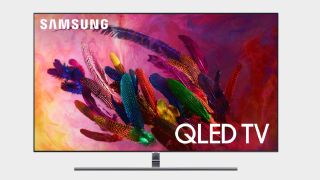
Response time
You'll hear a lot about the response time of a panel, especially when discussing gaming TVs. This is basically the speed at which a colour can change on your TV (eg. from black to white to black again). Most 4K TVs have response times quicker than we can perceive them, so it makes no real difference to gameplay outside the twitchiest of shooters. However, purists will want a TV with the quickest response time possible.
Refresh rate
This is the speed at which an image can be refreshed on your TV (and shouldn't be confused with response time). Basically, most TVs offer 60Hz-120Hz, although no 4K TV has anything higher and if you want 144Hz or even 240Hz, you need a contender for best gaming monitor. A 60Hz 4K TV, for example, refreshes the image on screen 60 times per second, which allows a certain level of smoothness to the image. If the TV refreshes at 120Hz, the image is twice as smooth, and you notice that in how slick the motion appears on screen. Many TVs 'game modes' will boost refresh rate artificially, usually by downgrading other display features (eg. reducing the brightness of your picture).
HDMI
This stands for High Definition Multimedia Interface, and it's the standard connection cable between your 4K TV and most devices. You need at least an HDMI 1.4 cable to carry a 4K signal, although most modern HDMIs are 2.0 cables, capable of carrying 4K signals at 60 frames per second. The majority of modern console games can't display at 4K 60fps, so as long as you have a 2.0 cable and 2.0 port on your TV, you're fine. And no, you don't need to buy expensive gold-plated HDMI cables to get a better picture - just the Amazon Basics will do just fine.
Best gaming TV in the UK: FAQs
What size TV is best for gaming?
We've got a whole guide that explains what size TV is best for gaming, but he's a quick summary. Simply put, screen size is dependent on the environment you're planning to use it in. Generally speaking, 43–55 inches is optimal for a typical living room area, but that'll vary based on factors like viewing distance.
What are good TV specs for gaming?
You can reach for the stars in terms of TV specs, but we'd advise matching a new screen up with your platform of choice. If you've got a shiny new console like the PS5, Xbox Series X, or even a high-spec PC, you'll want to opt for something that can handle higher refresh rates and 4K. Still rocking a PS4 or Xbox One? Then you could save some pennies by going for a lower-spec option that sticks to 60Hz, switching your focus to whether you'd prefer a vibrant OLED panel or something that uses LCD tech.
Is a 4K TV good for gaming?
4K TVs pair nicely with the latest consoles, but resolution isn't the only thing you should consider. Sure, using any old UHD display will enable you to enjoy your favourite PlayStation and Xbox games at a much higher resolution than before, but responsiveness could take a back seat. Thankfully, 4K 120Hz TVs are becoming more common, and while response times pale compared to gaming monitors, they are lower than ever.
Is LED or OLED better for gaming?
OLED displays (organic LED) aren't necessarily better for gaming, but the tech will produce vivid colors and contrast that traditional displays cannot. Unlike those screen types, OLED TVs don't require a backlight, as each individual pixel provides illumination instead. In turn, that also means each tiny diode can independently switch on and off, facilitating 'pure' blacks and standout whites.
How we test gaming TVs at 12DOVE
Why you can trust 12DOVE
At 12DOVE, with have a savvy team of hardware experts on hand to put gaming TVs to the test. Our ensemble of staff and freelancers spend hours putting the latest big screens through their paces, ensuring every recommended model's specs, design, features, and performance hold up to our standards.
Of course, we're also gamers, so we approach every gaming TV review as such. That sometimes means playing a chunk of the latest games using review models, which in turn helps us test things like resolution, refresh rate, and responsiveness. Naturally, it's also the best way to check whether a TV can provide a good gaming experience, facilitating great fidelity, colors, and contrast that boost immersion when visiting your favorite adventures.
For more information, check out our full Hardware Policy for an overview of how we test products for review.
Oh, and if you're on the lookout for something truly massive, you might want to consider one of the best projectors, best projectors for PS5 and Xbox Series X, or best 4K projector instead.
Sign up to the 12DOVE Newsletter
Weekly digests, tales from the communities you love, and more
Rob is the Deputy Editor of sister site, TechRadar Gaming, and has been in the games and tech industry for years. Prior to a recent stint as Gaming Editor at WePC, Rob was the Commissioning Editor for Hardware at 12DOVE, and was on the hardware team for more than four years, since its inception in late 2018. He is also a writer on games and has had work published over the last six years or so at the likes of Eurogamer, RPS, PCGN, and more. He is also a qualified landscape and garden designer, so does that in his spare time, while he is also an expert on the virtual landscapes and environments of games and loves to write about them too, including in an upcoming book on the topic!
- Duncan RobertsonHardware Editor

